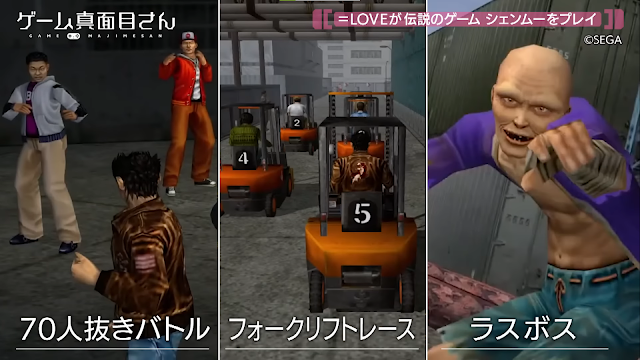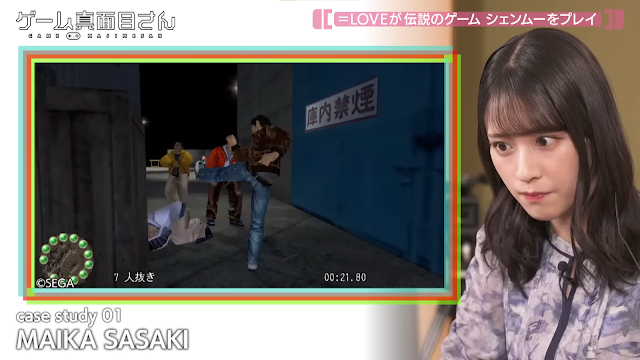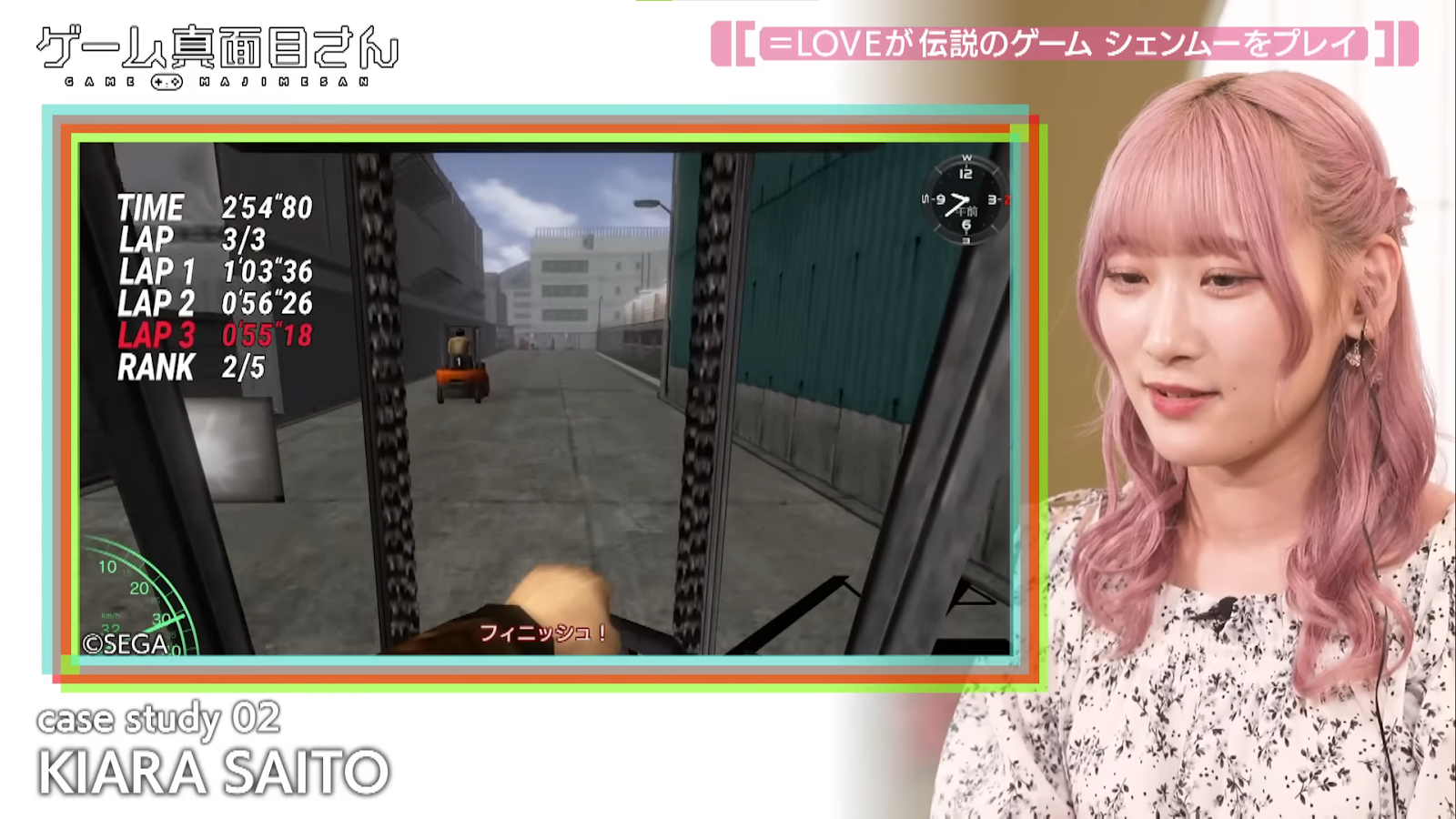TV Tokyo is showing a new video game-related variety show series called Game Majime-san which roughly translates to "Serious Gamers". It bills itself as a series in which "top idols of the Reiwa era [i.e. those of the modern day] play famous games seriously" and features the reactions of members of popular female idol groups playing classic video games for the first time.
The first two episodes covered Metal Gear Solid 3, and the latest episode was Shenmue! It features comments from Esra Krabbe of IGN Japan as well as Susumu Aketagawa (the original voice recording director of the first two games).
While the title of the show is clearly somewhat tongue-in-cheek - you'll find several references emphasizing how "serious" the players are with respect to their respective missions - it should help to introduce Shenmue to a younger generation of game players who may not know about it, and the background information it shares about the game is accurate. It even contains short interviews with journalists and a former project team member (not Yu Suzuki!).
As the broadcast was in the Japanese language, we present is a full transcription of the show in English, below.
Narrator: Good evening, everyone. This show delves into classic games in an academic way. Idol heartthrobs of the Reiwa era make a serious effort to clear the games. This is a "Super-hard Educational Game Variety" show!
The classic game we'll be talking about this time is...
 |
| Esra Krabbe (IGN Japan) |
Esra Krabbe (IGN Japan): I don't think I'd be sitting here right now if this game didn't exist.
Narrator: Released in 1999, it's the first entry in the legendary Shenmue game series. Developed on a massive scale as a flagship title for the dream game machine, the Dreamcast, its attention to detail is so impressive that it was even praised by Steven Spielberg.
So, how did Shenmue influence the gaming industry at the time?
The Impact of Shenmue on the Gaming Industry
Tadashi Miyokawa (Famitsu.com): As a game that used cutting-edge technology, it created a vast open world where players could freely interact, pioneering the open-world genre.
 |
| Tadashi Miyokawa (Famitsu.com) |
Within this world, not only the main characters but also various townspeople, NPCs, and supporting characters would respond individually to the player's actions. Your actions had an impact on the world, and the reactions you received varied depending on the time. This made it a highly engaging game that fans flocked to play.
And many people became game creators from its influence. There were many fans who wanted to create games like Shenmue, as well as developers of that time wanting to try their hand at making such an expansive game.
Narrator: One example of the astonishing attention to detail of this addictingly-detailed game is...
Full Voicing
Narrator: Despite having over 200 characters, even the non-playable characters (NPCs) have full voice lines, which set Shenmue apart from the rest.
Susumu Aketagawa (Shenmue I & II Voice Recording Director): It's something you wouldn't have found in most games.
Narrator: These are the words of Susumu Aketagawa, who was in charge of voice recording at the time.
 |
| Susumu Aketagawa (Shenmue I & II Voice Director) |
Susumu Aketagawa: In previous games, it was common that lines were voice recorded only to a certain extent. However, in the case of Shenmue, it was all able to be [recorded and] played back, including music and sound effects.
Moreover, there were multiple variations for each [dialogue] line, and we had to also record multiple response lines to match each of those variations. So, I was really impressed with how much the game could do.
I was involved over a long period of time. Taking into account the change of system [note from Switch: likely referring to the change of target console from Saturn to Dreamcast], it took about four years in total.
I think it was amazing. It was something that had been unthinkable in games up to then.
Narrator: Today let's try playing through parts in which Shenmue's almost ludicrous attention to detail can be felt in other areas apart from its full voicing.
 |
| The sections to be played: 70-Person Battle, Forklift Race and Last Boss |
70-Person Battle: Maika Sasaki
Maika Sasaki: I'm Serious Sasaki from =LOVE [Note from Switch: pronounced Equal Love].
Narrator: In this playthrough, we'll tackle a grand battle scene that is an essential part of discussing Shenmue.
Tadashi Miyokawa (Famitsu.com): Among other games, there had been one vs many battles using 2D graphics. But there hadn't been the case of the protagonist being surrounded by many enemies in a 3D setting. This hadn't been possible with the specs of gaming machines at the time.
However, the Dreamcast had the capability to do this, and that's how it was implemented.
Shenmue was created by the team that worked on Virtua Fighter, with the aim of turning Virtua Fighter into an RPG. So, they included the one-vs-many feature as a way to utilize the battle system.
Maika Sasaki: I'm feeling nervous! Here we go.
 |
| Maika Sasaki playing the 70-Person Battle |
[Maika makes good progress..]
This guy's strong; I bet he does karate!
Oh no! Come on, I'm begging you.
Narrator: Maika has defeated the enemies with kicking combos. But on reaching the 20th enemy, a mini-boss appears.
 |
| First mini-boss (Mad Angels' member Shingo Murasaki) |
Maika Sasaki: Stay away!
Oh no, oh no, oh no!
TV Staff: You've defeated him!
Maika Sasaki: Have I?
Narrator: Now, an even stronger mini-boss appears.
 |
| The next mini-boss (Sataoshi Nagata) |
Maika Sasaki: Oh, no!
He's carrying something! Unfair!
My legs are longer!
Take that!
Oh no, oh no, oh no!
I'll run away.
Oh no, oh no!
[Maika is defeated after 41 opponents]
Narrator: Maika is unable to compete with the mini-boss's strength.
The battle is thrilling even on the first playthrough. What's even more astonishing is the variety of techniques the main character can unleash.
Esra Krabbe (IGN Japan): In most fighting games, each character has a set of predetermined moves from the start. But in Shenmue, the protagonist learns various techniques from different masters along the way, allowing the player to use those techniques. In the park or at the dojo, you can practice these techniques, and they can evolve, changing their appearance and motion.
In the game's initial state, I think there are over 50 techniques, and if you include the ones you can learn later, there might be over 100.
Narrator: Fighting scenes aren't numerous in the game, but the number of techniques you can learn is staggering. That's what sets Shenmue apart.
Esra Krabbe: Furthermore, each technique is based on real martial arts that you'll recognize like karate, aikido, and various Chinese martial arts.
So, if you try karate for the first time, you'll recognize moves from Shenmue.
I think it's one of the highlights of Shenmue.
Narrator: It's safe to say that Mr. Krabbe dedicated his life to the game Shenmue.
We asked him to demonstrate those techniques for us.
[Esra demonstrates a punch and kicking combination. A side-by-side comparison with Shenmue is then shown.]
 |
| Esra Krabbe's martial arts demonstration |
Narrator: Both look splendid.
Back with Serious Sasaki, she has been playing for over an hour.
Maika Sasaki: What happened?
No. no!
Let me recover some strength!
TV Staff: You've beaten your record! 15 opponents to go.
Maika Sasaki: Oh no, I'm surrounded!
Narrator: And finally, the 70th person appears.
 |
| Meeting the final opponent (Pedro Warren) |
Maika Sasaki: Oh, here comes a tough-looking one!
He's the one I was looking to fight.
Who is he?
TV Staff: He's the main boss.
Maika Sasaki: I want to run away!
Narrator: Being the boss, he attacks using various types of techniques.
[Ryo is out of breath]
Maika Sasaki: I'm getting tired.
[Maika has Ryo run away from her opponent]
Narrator: Through long hours of play, Sasaki has mastered the art of evasion.
Maika Sasaki: Come on, please!
[Ryo defeats Pedro. TV Staff applaud]
 |
| Completion of the 70-person battle |
Forklift Racing & Part-Time Job: Kiara Saito
Narrator: Continuing on, the next player is...
Kiara Saito: I'm Serious Saito from =LOVE.
Narrator: The youngest member of =LOVE: Kiara Saito, also known as Serious Saito. This is another famous scene from Shenmue. She'll try her hand at working a part-time job on a forklift.
Esra Krabbe (IGN Japan): I feel that assigning work to the player is one of the elements that further enhances immersion. I think it's a really courageous game design to have players engage in boring tasks like this. Shenmue's ability to include something this without second thoughts is another of its awe-inspiring aspects.
 |
| Esra Krabbe |
[The opening scene of the forklift race plays. Mark wishes everyone good morning]
Narrator: First she'll take part in the forklift race that takes place every day before work.
 |
| Forklift race: first lap |
Kiara Saito: I'm scared, I'm scared!
It's important to drive safely.
Uh oh! Oh, made it.
Don't panic, don't panic. It's okay.
I'll slow down a bit.
Narrator: Serious Saito displays a splendid handling of the controls.
Kiara Saito: I'll take a short-cut through here.
Narrator: Gaining one position, she commences the second lap in 4th place.
[The TV Staff say "Ooh" as Ryo's forklift overtakes another.]
Kiara Saito: That puts me in third place.
Looking good!
I can't catch the next one at all. I'll take the short-cut!
[Ryo's forklift cuts inside the warehouse pillar and gains another place]
Going well!
[Ryo starts the final lap in 2nd, but is unable to catch the leader and finishes in that position.]
Ah, I couldn't do it!
 |
| End of the race |
So close! But I was second!
Narrator: Coming second is a pretty good result for one's first attempt at the forklift race. Having got the hang of forklift racing, Serious Saito will now experience working a part-time job for the first time in her life.
[The forks on Ryo's forklift rise]
Kiara Saito: It's going up! Now let's back up.
Where do I go.
Narrator: The crates must be delivered to Warehouse 18, as shown on the hand-drawn map.
Kiara Saito: Help! The point of view is a bit different from before. Hold on, where is it... this way.
[Onscreen text: "Seriously checking the map"]
 |
| Delivery to Warehouse No. 18 |
Kiara Saito: I'm making sure not to run over anyone.
Oh, do I have to set them down here one by one?
Well, that'll do, that'll do.
Narrator: By the way, in addition to the part-time job working the forklift, there are other meticulously-crafted mini-games. I hope you'll give them a try sometime.
QTEs: Iori Noguchi
Narrator: And the final player is...
Iori Noguchi: I'm Serious Noguchi from =LOVE.
I'm really bad at games.
TV Staff: So you don't play them much?
Iori Noguchi: Well I do, but I haven't played many fighting games like this before. Recently I've been getting into that game that's been appearing in smartphone ads, where you have to save the king. [laughs]
 |
| Iori Noguchi |
Tadashi Miyokawa (Famitsu.com): Incorporating game elements into cinematic scenes is called a "QTE" or Quick Time Event nowadays. At that time, they were called "Quick Timer Events."
When the protagonist, Ryo Hazuki, is about to be attacked, arrows appear, and you have to move the stick in that direction or press a button to attack.While these kinds of events weren't necessarily rare back then, they were unusual in cutting-edge games of the time. In games that incorporate cinematic elements after that, Quick Time Events (QTEs) gradually become more prevalent. So, I think it might be considered one of the origins of that trend.
Narrator: The story starts with the protagonist arriving at the harbor.
Narrator: It was all over while she was looking down.
And the hard part about this QTE system is that if you fail, you have to start again from the beginning.
[The introductory cut-scene restarts]
Iori Noguchi: This way!
[Ryo kicks an oncoming rider off his motorcycle, then picks it up and gets on]
Iori Noguchi: Oh! On a stolen bike.
[Charlie swings a stick and Ryo gets knocked off his bike. The QTE ends in failure again.]
Iori Noguchi: Yeah, that's true.
Narrator: Serious Noguchi seriously attempts to complete the section using her rhythm game skills, but...
Iori Noguchi: Sorry, I made a mistake! Sorry, I made a mistake!
Oh, whaaat...
Come on, come on! Yes!
TV Staff: The other way!
Narrator: She gets to the last part, but is unable to clear it.
It's now already her 10th attempt.
Iori Noguchi: I can't see anything at all!
This way!
[Ryo and Charlie pull up outside a warehouse]
Narrator: She has cleared the QTEs, but this is only one part of the story. Now, the real challenge begins.
Iori Noguchi: Is this also a rhythm game?
Behind you, behind you!
They're so close!
What's going on here?
It's like a judo club or something.
Narrator: This is supposedly her first battle scene, but she's defeating enemies one after another with throws.
In less than a minute, Serious Noguchi takes on the boss.
Iori Noguchi: I can't grab him!
I won't dodge. I won't run away!
[Charlie is defeated. Applause from the TV staff]
Iori Noguchi: My hands are shaking. Look!
[Laughter]
Narrator: Perhaps her combat sense has flourished as she clears the battle scene in less than two minutes. With this momentum, she takes on the final boss.
 |
| The final boss: Chai |
Iori Noguchi: He's missing teeth!
Ouch, ouch!
Move back, move back.
Ah, he's so persistent!
This is bad.
Run, run, run, run, run!
[Laughter]
Narrator: As expected, the final boss is strong. When your stamina is low, focus on recovering and wait for a chance to counter.
Iori Noguchi: He's really persistent!
I can't see my opponent's stamina level or anything. It's difficult.
 |
| Running from Chai |
Narrator: Ryo's stamina is fully restored.
Iori Noguchi: Take that!
[Chai is successfully defeated]
Narrator: In a surprising turn of events, the final boss has been defeated on her first attempt.
Iori Noguchi: I won!
Narrator: By the way, even among the staff who are good at games, no one was able to win on their first try.







No comments:
Post a Comment